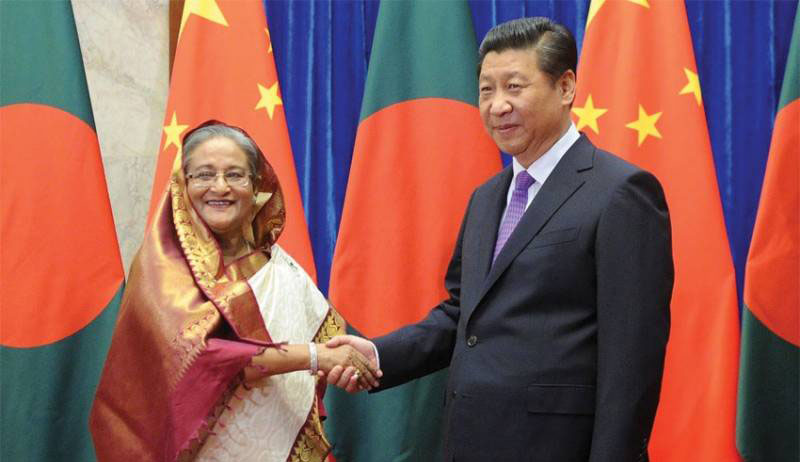 Arriving at Hazrat Shahjalal International Airport, Dhaka is always a happy moment for me. It was no different earlier this month when I went as a participant at the South Asia Economic Cooperation conference. A surprising traffic-free ride to the hotel was interspersed with an unlikely silent procession ahead of me.
Arriving at Hazrat Shahjalal International Airport, Dhaka is always a happy moment for me. It was no different earlier this month when I went as a participant at the South Asia Economic Cooperation conference. A surprising traffic-free ride to the hotel was interspersed with an unlikely silent procession ahead of me.
A group of around 50 people, seemingly Chinese and carrying a Chinese flag, marched along the main road to the city which I then realised was to mark the visit of Chinese President Xi Jinping visit to Bangladesh, a visit that was happening at that level after a gap of 30 years. Although the President’s stopover at Dhaka, en route to the BRICS Summit in Goa, was not more than 24 hours the city seemed to have left no stone unturned to impress the visiting head of state.
The Chinese delegation’s presence at the same hotel where I and other conference participants were staying was something of an eye-opener as it transformed a friendly hotel lobby area to a near combat zone. Huge larger than life cutouts of both the leaders, Bangladesh Prime Minister Sheikh Hasina and Xi, were splashed across nearly all the main roads of Dhaka not to mention the bright Chinese decorative bulbs that were strung along on both sides brightening up the usually dark roads of the Bangladesh capital. What was particularly distressing for other hotel guests was the attempt to close off public space, including access to the hotel, and even returning to the hotel at night proved an ordeal in the face of Chinese paranoia about their security that had got them to ask the hotel to move other guests out during their stay.
The visit resulted in signing of 27 agreements and MoUs between the two governments involving an amount of over USD 20 billion. There was also some reporting about China waiving off USD 24 billion worth of loans for Bangladesh, which is neither unprecedented nor unusual, given the rapidly deepening bilateral links. Indeed, one has to follow the Sino-Bangladeshi bilateral trajectory to understand how pragmatism triumphs over ideology.
China, once reluctant to even recognise the independent nation-state of Bangladesh, now shares a strategic partnership with bilateral trade of over USD 10 billion with more than USD 9 billion in favour of the Asian giant. However, this rather substantial trade gap has never been a bone of contention with Bangladesh and is in sharp contrast to the constant refrains from Bangladesh till sometime back to the trade deficit around USD 6 billion an year ago vis-à-vis India.
China has for long been involved in various infrastructural projects in Bangladesh and 13 of these bilateral agreements covered infrastructure, construction, energy and transportation. The Sino-Bangladeshi joint venture, the 1,224 MW thermal power plant at Banshkali, was formally inaugurated on this visit. While noises about the Indo-Bangladeshi bilateral energy project at Rampal is becoming a subject of growing negative speculation not much protest has been heard over the Banskhali coastal project which has already resulted in death of four locals protesting about the possible adverse effects over their local water and ecological systems thus impacting upon the livelihood patterns of the inhabitants in the area.
It is not difficult to see why India and China are viewed through distinctly different lenses by Bangladesh. In the absence of any historic baggage and resultant absence of a hostile domestic constituency, Bangladesh is able to pursue an irritant-free policy towards China. Its leaders or political parties are not unduly worried about getting uncomfortably close to Beijing.
The Chinese refusal to interfere in the domestic debates within Bangladesh and their non-preference of any particular party or ideology has also worked well for Beijing. Its influence and growing leverage over Dhaka is obvious and, presently, the bilateral convergence of interest is wide and encompassing various levels.
On the other hand, the Bangladeshi engagement with India is marred by history and geography-related problems and is a victim of confrontational domestic politics. Although Indo-Bangladeshi ties have seen a breakthrough in recent times, the perceived Indian high-handedness bogey comes to the fore again and again.
Bangladesh views China as a reliable partner and India as a close neighbour that offers promise but on which it is unable to repose its total trust upon. As the fleeting but bountiful visit of Xi Jinping reveals, the Sino-Bangladeshi relation receives blanket approval at all levels but the Indo-Bangladeshi engagement lacks similar widespread popular support within Bangladesh. Forty years down the line it is not enough to attribute this gap to our geographic and historic causes alone; indeed there are deeper political fissures that needs to be addressed.




